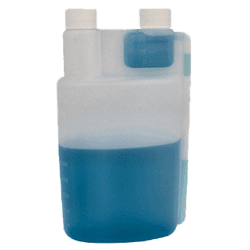Many are mimicking nature by feeding their plants a small amount of fertilizer, but doing so often. When I still had a greenhouse, I fed at 25 ppm N at every watering, but now II feed my plants a 100 ppm N solution weekly, but to do that, I need to figure out how to measure fractions of a teaspoon per gallon, which is a pain, so...
Solve that problem by making a fertilizer concentrate in a "Self Measuring" bottle!
These are one-quart dispensing bottles that deliver one ounce/30 ml of liquid at a time. Preparation is simple:
Solve that problem by making a fertilizer concentrate in a "Self Measuring" bottle!
These are one-quart dispensing bottles that deliver one ounce/30 ml of liquid at a time. Preparation is simple:
- Decide what fertilizer concentration you want to apply to your plants. That will be related to your feeding frequency. For example, 100 ppm N is a good level for weekly feeding.
- Using the nitrogen content of your fertilizer, use my Simple Fertilizing Mixing Calculator to determine the teaspoons-per-gallon needed for the chosen concentration. For K-Lite, which contains 12.9% nitrogen, that is 0.62 teaspoons/gallon for 100 ppm N.
- Multiply that result by 32 to get the total amount of fertilizer to add to the dispenser bottle. Using our current example, that's 32 x 0.62 = 19.84 teaspoons. Feel free to round up or down for convenience - I'd just use 20 in this case.
- Remove the cap to the larger volume of the container (on the left in the image), pour in the fertilizer powder, fill with water to the 32-ounce mark, reseal the bottle and shake to dissolve all of the powder.
- Shake the bottle well to fully disperse any sediment that may have formed.
- Remove the cap from the smaller dispensing chamber (the one on the right) and squeeze the larger side until you have filled the chamber to the 1-ounce (30 ml) mark.
- Pour that into your mixing container - one, 1-ounce volume for every gallon you need.
- Replace the cap and store until the concentrate is needed again.





































